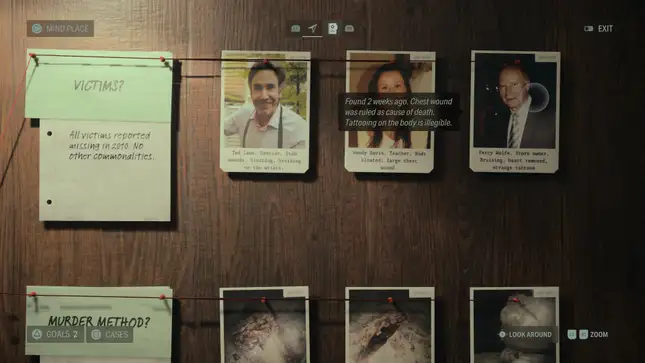Navigating Digital Worlds
Introduction Video games have evolved significantly, offering players an array of interactive experiences. Key to these experiences is the user interface (UI), which bridges the gap between player and virtual world.
Some games have a clear path with set goals, for players who prefer a more guided and structured experience. On the other hand, some games let players decide what they want to do and how they want to do it. Allowing players to make their own path in a game. We're going to look at different games to see how these two ways of making games change how the player experience.
Player Agency and Customization:
The Case Board in "Alan Wake 2" gives players the ability to tailor their experience based on their individual play style or preferences. Players choose how to arrange clues on the Case Board to solve cases, offering a personalized approach to problem-solving within the game's narrative.
Non-Linear Exploration:
"Alan Wake 2" supports a non-linear approach to gameplay. Players can explore narrative threads in any order they choose, using the Case Board to piece together the story. This flexibility in narrative exploration allows players to engage with the game's story in a manner that suits their personal play style.
Enhancing the Narrative and Exploration Experience:
In "Alan Wake 2", the Case Board is not just a gameplay tool but a central part of the narrative. It plays a critical role in unfolding the story, as players make connections between clues. This integration of the Case Board into the narrative enhances the overall storytelling experience, making it more engaging and interactive.
Player-Driven Progression:
The Case Board in "Alan Wake 2" places progression control in the hands of the players. It allows players to advance the investigation at their own pace, reflecting their choices and deductions. This system empowers players to drive the narrative forward based on their actions and decisions.
Interactive and Immersive Tools:
The Case Board in "Alan Wake 2" is an interactive tool that immerses players more deeply in the game world. It provides a tangible way for players to engage with the game, particularly in solving mysteries and connecting various narrative elements. Through this interaction, the game becomes a more immersive and engaging experience.
Alan Wake 2's Case Board vs. Ghost Recon: Breakpoint's Mission Screen
UI Layout: "Alan Wake 2" features a Case Board where players organize clues to advance the story. This interface is reminiscent of a detective's investigation board, presenting a web of interconnected clues and questions. "Ghost Recon: Breakpoint," on the other hand, employs a mission screen that lists available missions in a straightforward, menu-like format.
Interaction Freedom: The Case Board in "Alan Wake 2" offers high interaction freedom, enabling players to choose how to arrange and connect clues. This UI layout demands active engagement and critical thinking. Conversely, "Ghost Recon: Breakpoint" provides a more streamlined approach, allowing players to select missions but with limited interactive depth.
Trade-offs: The trade-off in "Alan Wake 2" is complexity versus depth of engagement. The more intricate UI layout of the Case Board provides a richer, more immersive experience at the cost of simplicity. "Ghost Recon: Breakpoint" offers ease of use and quick access to missions, trading off the deeper engagement for straightforward functionality.
Player Agency: Both games offer player agency, but in different ways. "Alan Wake 2" allows for creative problem-solving and narrative exploration, while "Ghost Recon: Breakpoint" focuses on tactical and strategic choices in mission selection.
2. Elden Ring's Maps vs. Far Cry's Map
UI Layout: "Elden Ring" presents a map where players can place custom markers, granting them the freedom to chart their journey. The map is detailed yet open to player interpretation. In contrast, the "Far Cry" series uses a tower mechanic where climbing towers reveals the map, showing points of interest in a more defined manner.
Interaction Freedom: "Elden Ring" offers a higher degree of freedom in exploration, as players decide where to place markers and which areas to explore. The "Far Cry" map, though less interactive, provides a clear, guided exploration path, revealing the game world in a structured way.
Trade-offs: The trade-off in "Elden Ring" is open-ended exploration versus potential for disorientation. Players have complete freedom to explore, but this can be overwhelming. "Far Cry" simplifies exploration, making it more accessible but potentially less rewarding for players seeking a more explorative experience.
Player Agency: "Elden Ring" excels in offering players agency in exploration and discovery, while "Far Cry" provides a guided experience with less emphasis on self-directed exploration.
Conclusion
The UI layout and interaction freedom in video games significantly influence player agency. Games like "Alan Wake 2" and "Elden Ring" offer complex, interactive UIs that provide depth and engagement, catering to players who enjoy exploration and problem-solving. In contrast, "Ghost Recon: Breakpoint" and the "Far Cry" series opt for more straightforward, user-friendly interfaces, appealing to players who prefer a more guided and structured experience. Understanding these trade-offs is crucial for both game developers and players, as it shapes the overall gaming experience and the level of engagement players have with the virtual world.


